Magnesium bath salts side effects. Epsom Salt: Benefits, Uses, and Side Effects of Magnesium Sulfate
What are the benefits of Epsom salt. How can Epsom salt be used for health and beauty. What are the potential side effects of using Epsom salt. Is Epsom salt safe for everyone to use. How does Epsom salt compare to other magnesium supplements. Can Epsom salt baths really increase magnesium levels in the body. What precautions should be taken when using Epsom salt.
What Is Epsom Salt and How Does It Work?
Epsom salt, scientifically known as magnesium sulfate, is a mineral compound that has gained popularity for its potential health and beauty benefits. Despite its name, Epsom salt is not related to table salt and has a distinctly different chemical composition. It consists of magnesium, sulfur, and oxygen, forming a crystalline structure that resembles common salt.
When dissolved in water, Epsom salt separates into magnesium and sulfate ions. This property is the basis for many of its purported benefits, as some believe these ions can be absorbed through the skin during baths. However, scientific evidence supporting this claim is limited and controversial.

The Chemistry Behind Epsom Salt
How does Epsom salt differ from regular table salt? Unlike sodium chloride (table salt), Epsom salt has a bitter taste and is not suitable for culinary use. Its chemical formula is MgSO4·7H2O, indicating that each molecule contains one magnesium atom, one sulfur atom, four oxygen atoms, and seven water molecules.
- Chemical composition: Magnesium sulfate heptahydrate
- Appearance: White, crystalline solid
- Solubility: Highly soluble in water
- pH: Neutral (around 7)
The Potential Health Benefits of Epsom Salt
Epsom salt has been used for centuries as a natural remedy for various ailments. While scientific research is still catching up with traditional uses, several potential benefits have been associated with Epsom salt.
Magnesium Supplementation
Can Epsom salt baths increase magnesium levels in the body? This question has been the subject of debate among researchers and health professionals. While some claim that magnesium can be absorbed through the skin during Epsom salt baths, the evidence is inconclusive.

An unpublished study involving 19 participants suggested that most subjects showed increased blood magnesium levels after soaking in an Epsom salt bath. However, this study lacked statistical analysis and a control group, making its findings questionable. More robust research is needed to confirm whether transdermal magnesium absorption from Epsom salt baths is significant.
Stress Reduction and Sleep Improvement
Many people report feeling more relaxed and sleeping better after taking Epsom salt baths. While these effects may be partially attributed to the warm bath itself, magnesium plays a crucial role in stress management and sleep regulation.
Magnesium helps the brain produce neurotransmitters that promote sleep and reduce stress. However, it’s unclear whether the magnesium from Epsom salt baths contributes significantly to these effects or if the benefits are primarily due to the relaxing nature of a warm bath.
Constipation Relief
Epsom salt has been used as a laxative for many years. When taken orally, it can help alleviate constipation by drawing water into the colon, promoting bowel movements. However, it’s essential to use Epsom salt as a laxative only under medical supervision, as improper use can lead to electrolyte imbalances and other complications.

Common Uses of Epsom Salt in Health and Beauty
Epsom salt’s versatility extends beyond its potential health benefits. It has found its way into various health and beauty routines, offering a natural and affordable option for self-care.
Bath Soaks
The most popular use of Epsom salt is in bath soaks. Adding Epsom salt to warm bathwater is believed to help soothe sore muscles, reduce stress, and promote relaxation. While the scientific evidence for these benefits is limited, many people find Epsom salt baths to be a comforting and enjoyable experience.
Exfoliation
Epsom salt’s crystalline structure makes it an excellent natural exfoliant. When mixed with a carrier oil or body wash, it can help remove dead skin cells, leaving the skin feeling smooth and refreshed. However, it’s important to use gentle pressure to avoid irritating the skin.
Foot Soaks
Epsom salt foot baths are popular for relieving tired, achy feet. The warm water combined with Epsom salt is thought to help reduce inflammation and soften rough skin. This can be particularly soothing after a long day of standing or walking.

Potential Side Effects and Precautions
While Epsom salt is generally considered safe for most people when used as directed, there are some potential side effects and precautions to keep in mind.
Oral Consumption Risks
When taken orally as a laxative, Epsom salt can cause:
- Diarrhea
- Nausea
- Abdominal cramping
- Electrolyte imbalances
It’s crucial to follow dosage instructions carefully and consult with a healthcare provider before using Epsom salt as a laxative, especially if you have kidney problems or other health conditions.
Skin Irritation
Some people may experience skin irritation or allergic reactions when using Epsom salt topically. It’s advisable to do a patch test before using it in a bath or as an exfoliant, especially if you have sensitive skin.
Magnesium Toxicity
While magnesium toxicity from Epsom salt baths is rare, it’s theoretically possible, particularly for people with kidney problems. Symptoms of magnesium toxicity can include:
- Nausea and vomiting
- Confusion
- Muscle weakness
- Irregular heartbeat
If you experience any of these symptoms after using Epsom salt, seek medical attention immediately.
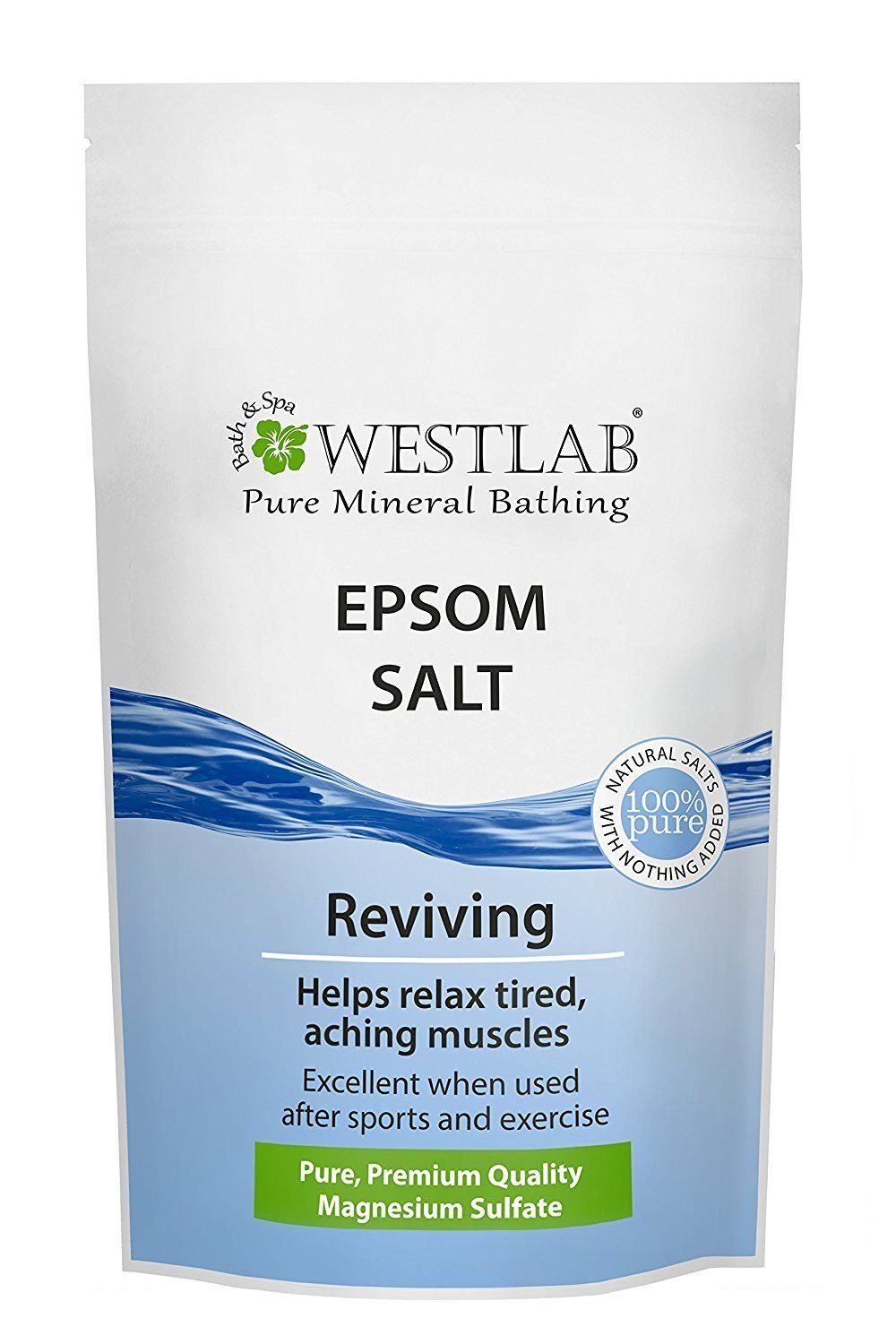
Epsom Salt vs. Other Magnesium Supplements
How does Epsom salt compare to other forms of magnesium supplementation? While Epsom salt can be used as a magnesium supplement when taken orally, it may not be the most effective or pleasant option due to its laxative effects and bitter taste.
Other common forms of magnesium supplements include:
- Magnesium citrate
- Magnesium glycinate
- Magnesium oxide
- Magnesium chloride
These forms are typically better absorbed by the body when taken orally and may be more suitable for addressing magnesium deficiency.
Bioavailability Considerations
The bioavailability of magnesium from Epsom salt, particularly when used in baths, is a subject of debate. While some studies suggest possible transdermal absorption, the amount is likely to be minimal compared to oral supplementation. For those looking to increase their magnesium intake, dietary sources and oral supplements under medical supervision may be more reliable options.
Incorporating Epsom Salt into Your Wellness Routine
If you’re interested in exploring the potential benefits of Epsom salt, there are several ways to incorporate it into your wellness routine safely and effectively.
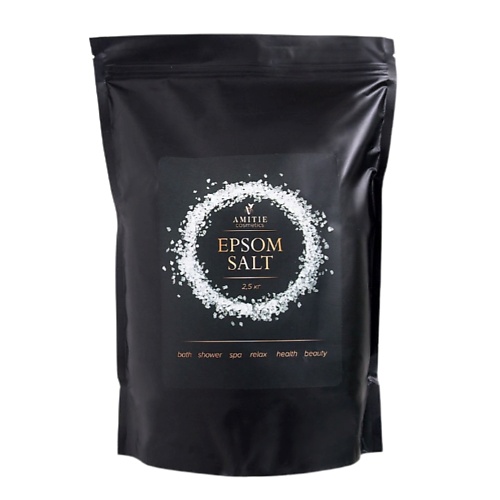
Bath Soak Recipe
For a relaxing Epsom salt bath, try this simple recipe:
- Fill your bathtub with warm water
- Add 1-2 cups of Epsom salt
- Stir to dissolve the salt completely
- Soak for 15-20 minutes
- Rinse off with clean water after bathing
You can enhance your bath experience by adding a few drops of essential oils for aromatherapy benefits.
Foot Soak for Tired Feet
To soothe tired, achy feet:
- Fill a basin with warm water
- Add 1/2 cup of Epsom salt
- Soak your feet for 15-20 minutes
- Gently exfoliate with a pumice stone if desired
- Rinse and moisturize your feet
This can be especially refreshing after a long day of standing or walking.
Exfoliating Scrub
Create a gentle exfoliating scrub by mixing:
- 1/2 cup Epsom salt
- 1/4 cup coconut oil or olive oil
- A few drops of your favorite essential oil (optional)
Gently massage the scrub onto damp skin in circular motions, then rinse thoroughly. Use this scrub once or twice a week for smooth, refreshed skin.
The Science Behind Epsom Salt: Current Research and Future Directions
While Epsom salt has been used for centuries, scientific research on its benefits is still evolving. Current studies have provided mixed results, and more rigorous research is needed to fully understand its effects on health and wellness.
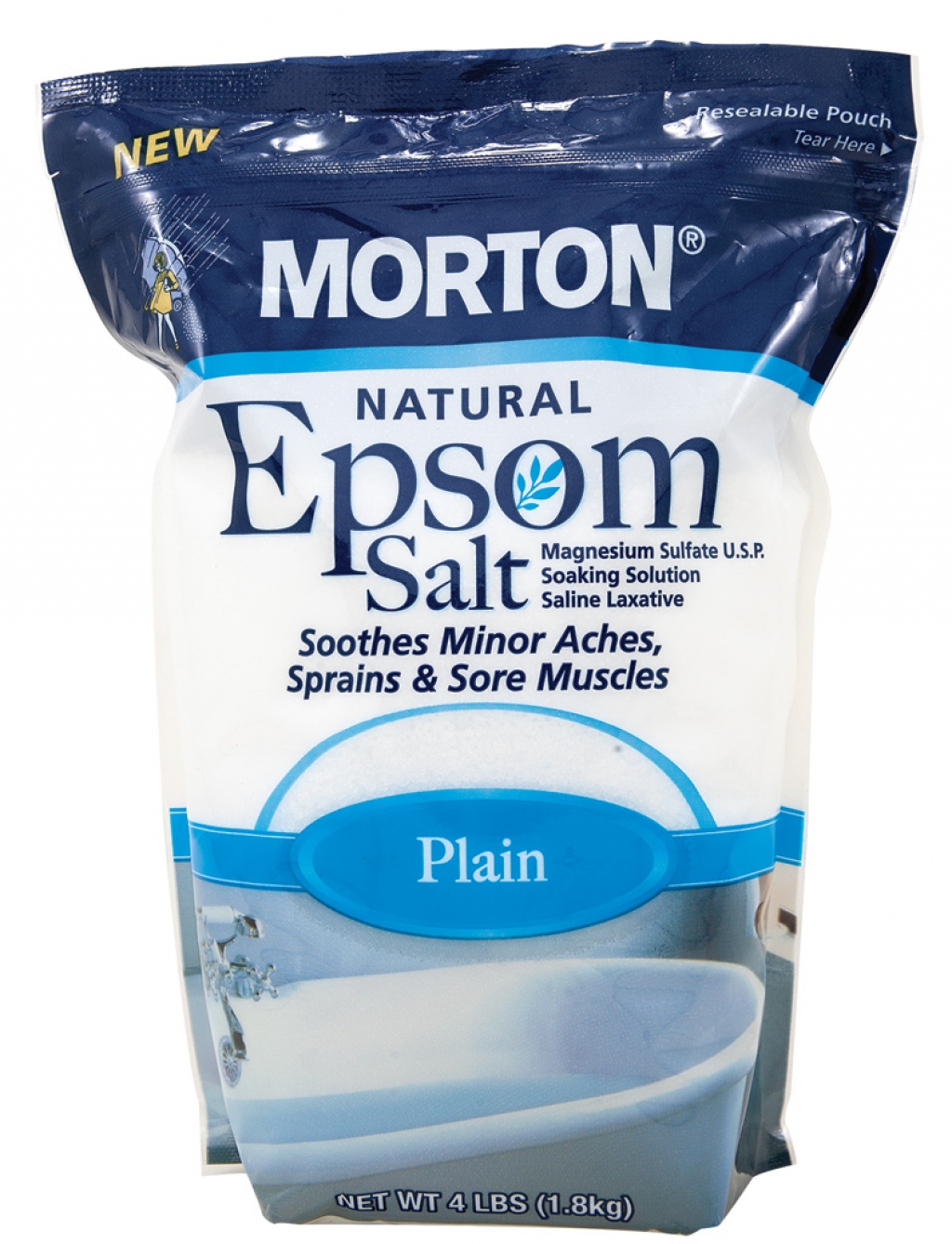
Transdermal Magnesium Absorption
One of the most contentious areas of Epsom salt research is the possibility of transdermal magnesium absorption. Some studies have suggested that magnesium can be absorbed through the skin, while others have found no significant increase in blood magnesium levels after Epsom salt baths.
A 2017 review published in the journal “Nutrients” concluded that the evidence for transdermal magnesium absorption is limited and of poor quality. The authors called for more robust, well-designed studies to investigate this potential mechanism.
Pain Relief and Muscle Recovery
Another area of interest is the potential for Epsom salt baths to aid in pain relief and muscle recovery. While anecdotal evidence is abundant, scientific studies have yielded mixed results.
A small study published in the “Journal of Integrative Medicine” in 2015 found that Epsom salt baths may help reduce inflammation and pain in patients with fibromyalgia. However, larger, more comprehensive studies are needed to confirm these findings and explore potential benefits for other conditions.

Future Research Directions
As interest in natural remedies and complementary therapies continues to grow, future research on Epsom salt may focus on:
- Developing more sensitive methods to measure transdermal magnesium absorption
- Investigating the potential synergistic effects of Epsom salt baths and other relaxation techniques
- Exploring the impact of Epsom salt on specific health conditions, such as arthritis or athletic performance
- Examining the long-term effects of regular Epsom salt use on overall health and well-being
These research directions could help clarify the mechanisms behind Epsom salt’s reported benefits and provide more concrete evidence for its use in health and wellness practices.
Epsom Salt in Traditional and Alternative Medicine
Epsom salt has a long history of use in both traditional and alternative medicine practices. Its versatility and perceived benefits have made it a popular remedy across various cultures and healing traditions.
Historical Uses
The discovery of Epsom salt dates back to the early 17th century in Epsom, England, where it was found in natural spring water. Since then, it has been used for various purposes:
- As a purgative in medieval medicine
- To treat cattle in agricultural practices
- As a soothing soak for tired feet among manual laborers
- In spa treatments for the wealthy elite
These historical uses laid the foundation for Epsom salt’s continued popularity in modern times.
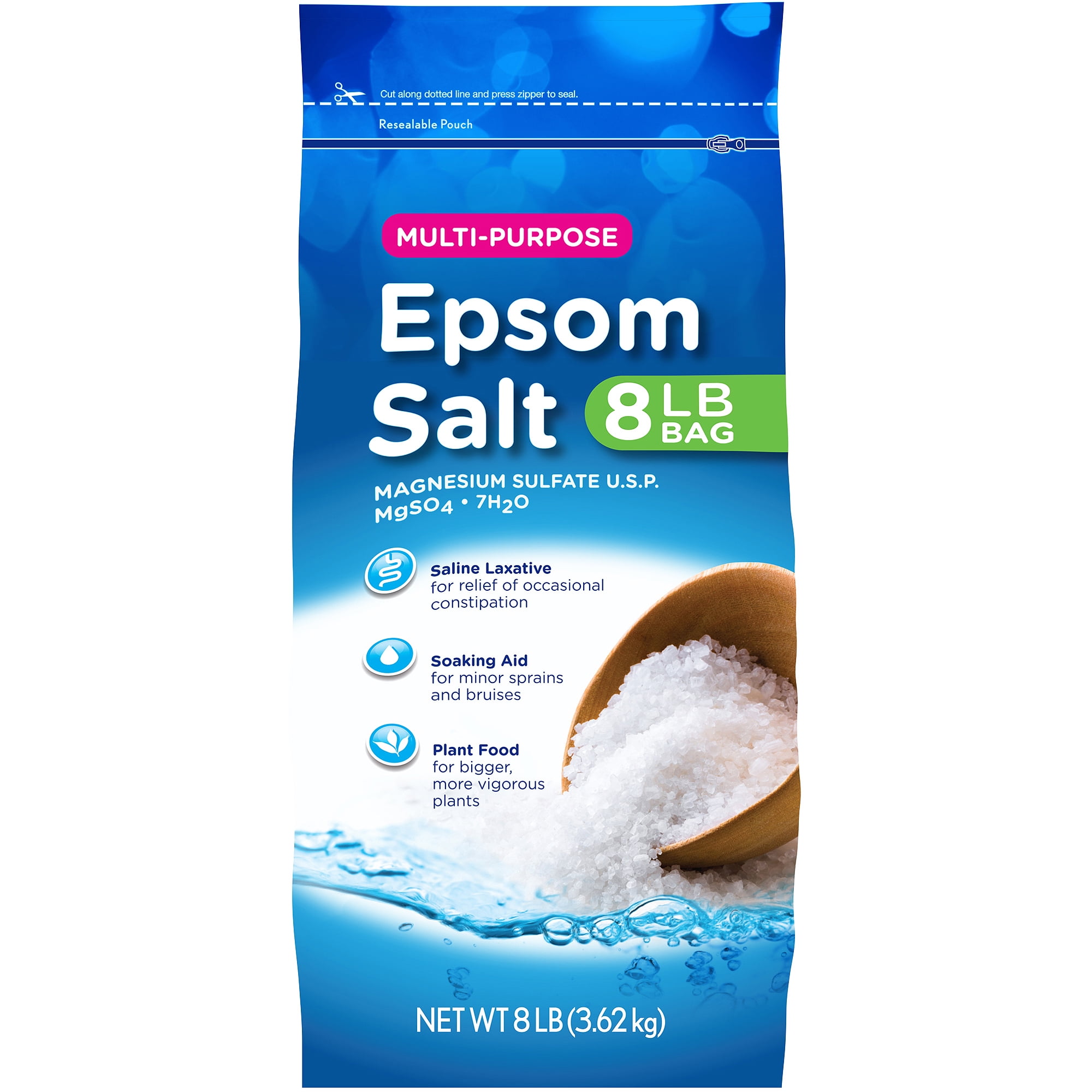
Integration with Modern Wellness Practices
Today, Epsom salt has found its place in various wellness and alternative medicine practices:
- Naturopathy: Used as a natural remedy for detoxification and mineral supplementation
- Sports medicine: Incorporated into recovery routines for athletes
- Aromatherapy: Combined with essential oils for enhanced relaxation benefits
- Reflexology: Used in foot soaks to complement foot massage techniques
While scientific evidence for some of these uses is limited, many practitioners and individuals report positive experiences with Epsom salt treatments.
Potential Mechanisms of Action
Several theories attempt to explain the potential benefits of Epsom salt in alternative medicine:
- Osmosis: The high concentration of magnesium sulfate in Epsom salt baths may draw toxins out of the body through the skin.
- Mineral absorption: Some believe that magnesium and sulfate ions can be absorbed through the skin, replenishing these important minerals in the body.
- Relaxation response: The act of taking a warm bath, combined with the perceived benefits of Epsom salt, may trigger a relaxation response in the body, leading to reduced stress and improved well-being.
While these mechanisms are plausible, more research is needed to fully understand how Epsom salt might exert its effects on the body.

As research continues to explore the potential benefits and mechanisms of Epsom salt, it remains a popular and accessible option for those seeking natural remedies. Whether used for relaxation, pain relief, or as part of a broader wellness routine, Epsom salt continues to captivate both traditional and modern approaches to health and well-being. As with any health practice, it’s important to approach Epsom salt use with an open mind, balanced by a critical understanding of the current scientific evidence and potential risks.
Benefits, Uses, and Side Effects
Epsom salt can be used as a supplement, bath salt, or beauty product. It’s also associated with very few side effects and may offer several potential health benefits.
Epsom salt is a popular remedy for many ailments.
People use it to ease health problems, such as muscle soreness and stress. It’s also affordable, easy to use, and harmless when used appropriately.
This article provides a comprehensive overview of Epsom salt, including its benefits, uses, and side effects.
Epsom salt is also known as magnesium sulfate. It’s a chemical compound made up of magnesium, sulfur, and oxygen.
Despite its name, Epsom salt is a completely different compound than table salt. It was most likely termed “salt” because of its chemical structure.
It has an appearance similar to table salt and is often dissolved in baths, which is why you may also know it as “bath salt.” While it looks similar to table salt, its taste is distinctly different. Epsom salt is quite bitter and unpalatable.
Epsom salt is quite bitter and unpalatable.
Some people still consume it by dissolving the salt in water and drinking it. However, due to its taste, you probably don’t want to add it to food.
For hundreds of years, this salt has been used to treat ailments, such as electrolyte abnormalities, constipation, and eclampsia. Unfortunately, its effects on many other conditions are not well researched (1).
Most of the reported benefits of Epsom salt are attributed to its magnesium, a mineral that a lot of people do not get enough of (2).
You can find Epsom salt online and at most drug and grocery stores. It’s typically located in the pharmacy or cosmetic area.
Summary
Epsom salt — otherwise known as bath salt or magnesium sulfate — is a mineral compound believed to have many health benefits.
When Epsom salt is dissolved in water, it releases magnesium and sulfate ions.
The idea is that these particles can be absorbed through your skin, providing you with magnesium and sulfates — which serve important bodily functions.
Despite claims on the contrary, there is no good evidence that magnesium or sulfates are absorbed into your body through the skin (3).
Yet the most common use for Epsom salt is in baths, where it is simply dissolved in bathwater.
It can also be applied to your skin as a cosmetic or taken by mouth as a laxative or magnesium supplement. However, because of its laxative effects, it might not be an ideal choice as a magnesium supplement if your goal is to prevent deficiency (4).
Summary
Epsom salt dissolves in water and can be added to baths or used as a cosmetic. However, there is no evidence that your body can absorb its minerals through the skin.
Many people, including some healthcare professionals, claim Epsom salt is therapeutic and use it as an alternative treatment for several conditions.
Provides magnesium
Magnesium is the fourth most abundant mineral in the body, the first being calcium (5).
It is involved in more than 300 biochemical reactions that benefit your heart and nervous system (5).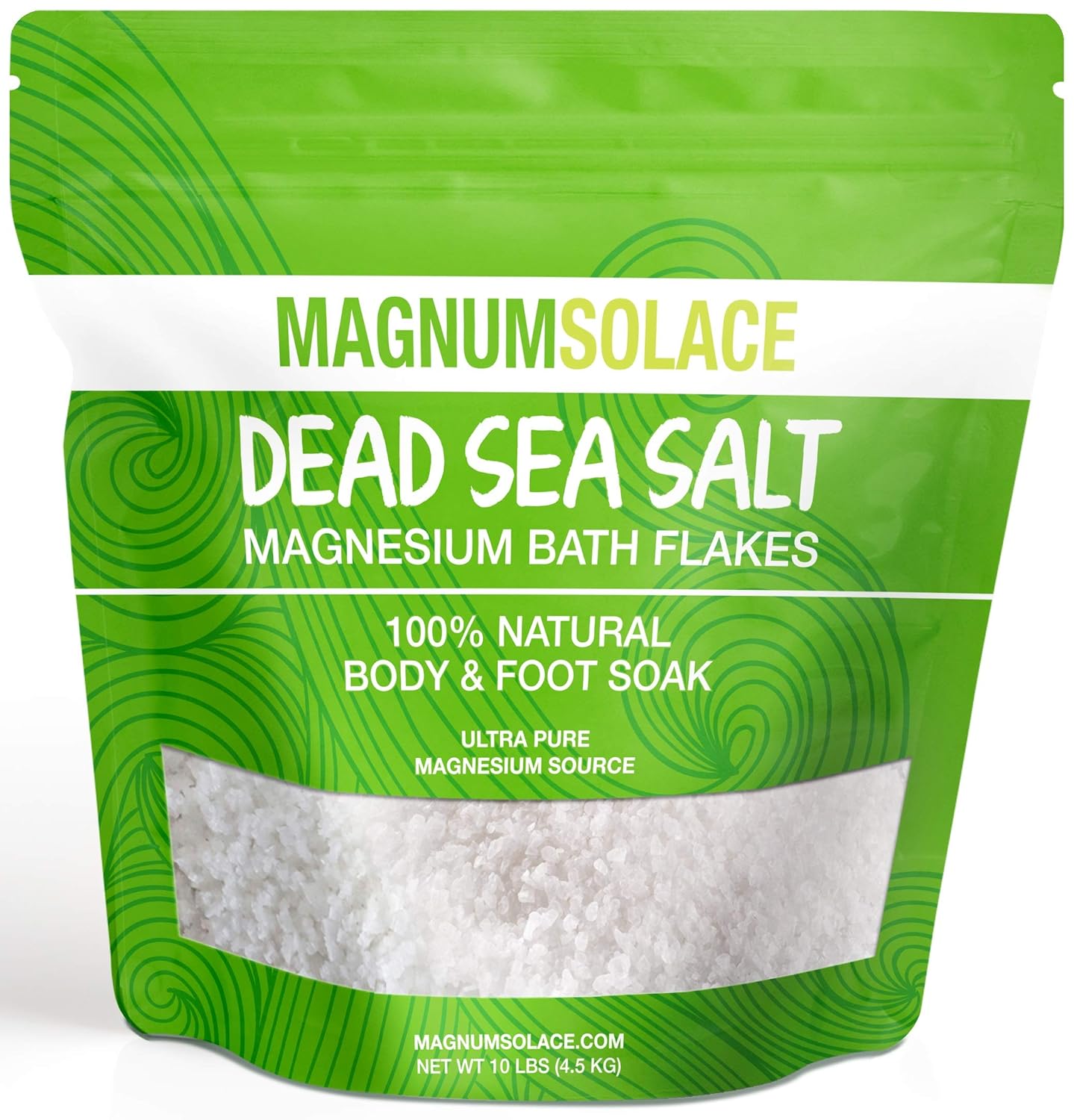
Still, many people do not consume enough magnesium (2).
While magnesium sulfate can be used as a magnesium supplement, some people claim that magnesium may be better absorbed via Epsom salt baths than when taken by mouth.
However, this claim is not based on any available evidence and research shows that magnesium sulfate is very poorly absorbed, even when taken orally (6).
Proponents of this theory point to an unpublished study in 19 healthy people. The researchers claimed that all but three of the participants showed higher blood magnesium levels after soaking in an Epsom salt bath.
However, no statistical tests were performed and the study lacked a control group (7).
Some other studies have also evaluated the effects of Epsom salt baths on blood magnesium levels, but these studies have turned up conflicting results and are of questionable quality (3).
Therefore, while it may be possible for magnesium to be absorbed through the skin, more large, high quality studies are needed (3).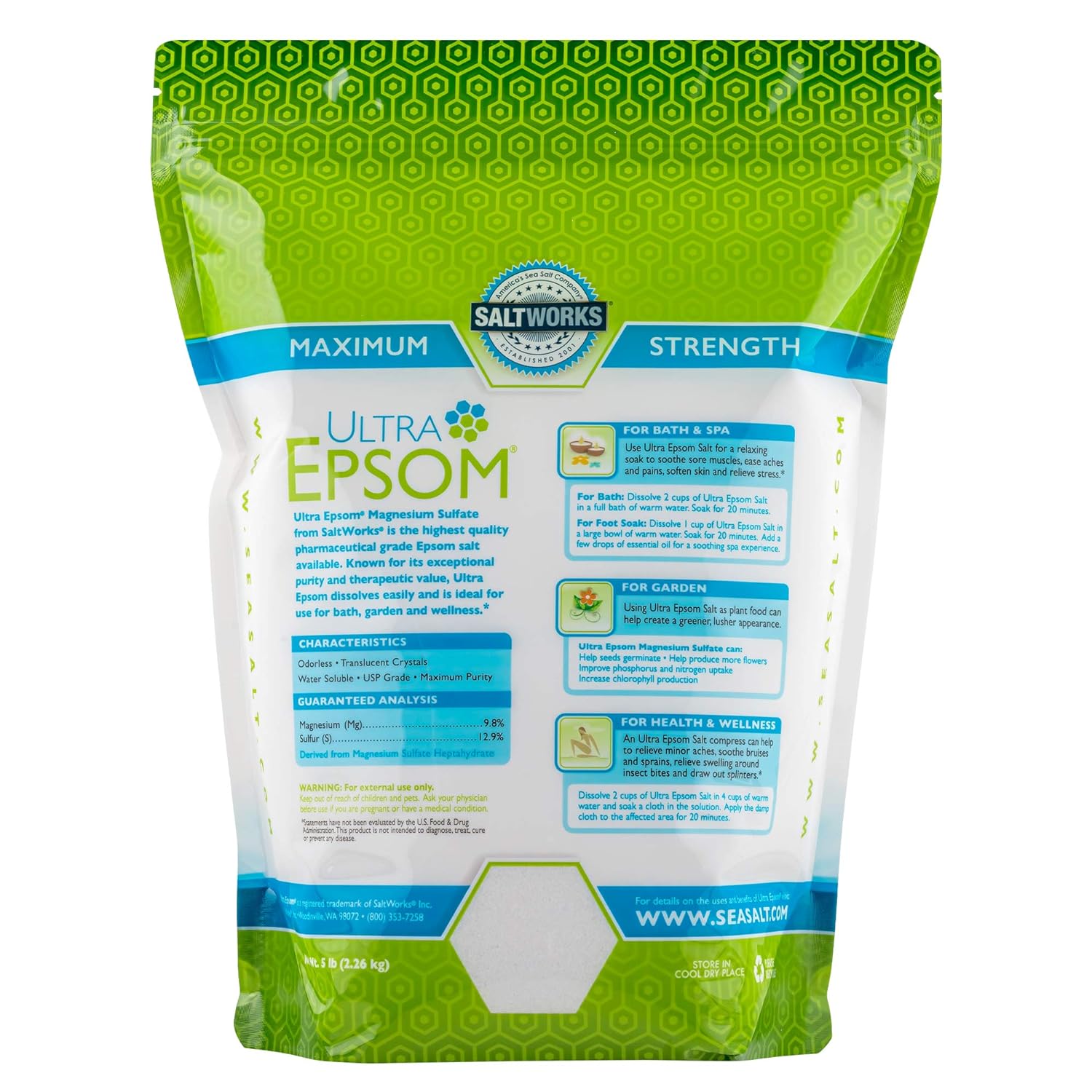
Promotes sleep and stress reduction
Adequate magnesium levels are essential for sleep and stress management, likely because magnesium helps your brain produce neurotransmitters that induce sleep and reduce stress (8, 9).
Low magnesium levels may negatively affect sleep quality and stress. Some people claim that taking Epsom salt baths can reverse these issues by allowing your body to absorb magnesium through the skin. However, this hasn’t been scientifically proven.
It’s also possible that the calming effects of Epsom salt baths are simply due to the relaxation caused by taking hot baths.
Helps with constipation
Magnesium is often used to treat constipation.
It appears to be helpful because it draws water into your colon, which promotes bowel movements (10).
Most often, magnesium is taken by mouth for constipation relief in the form of magnesium citrate, magnesium hydroxide, or magnesium oxide (11).
Taking Epsom salt may also be effective, although it is not as well-studied as other forms.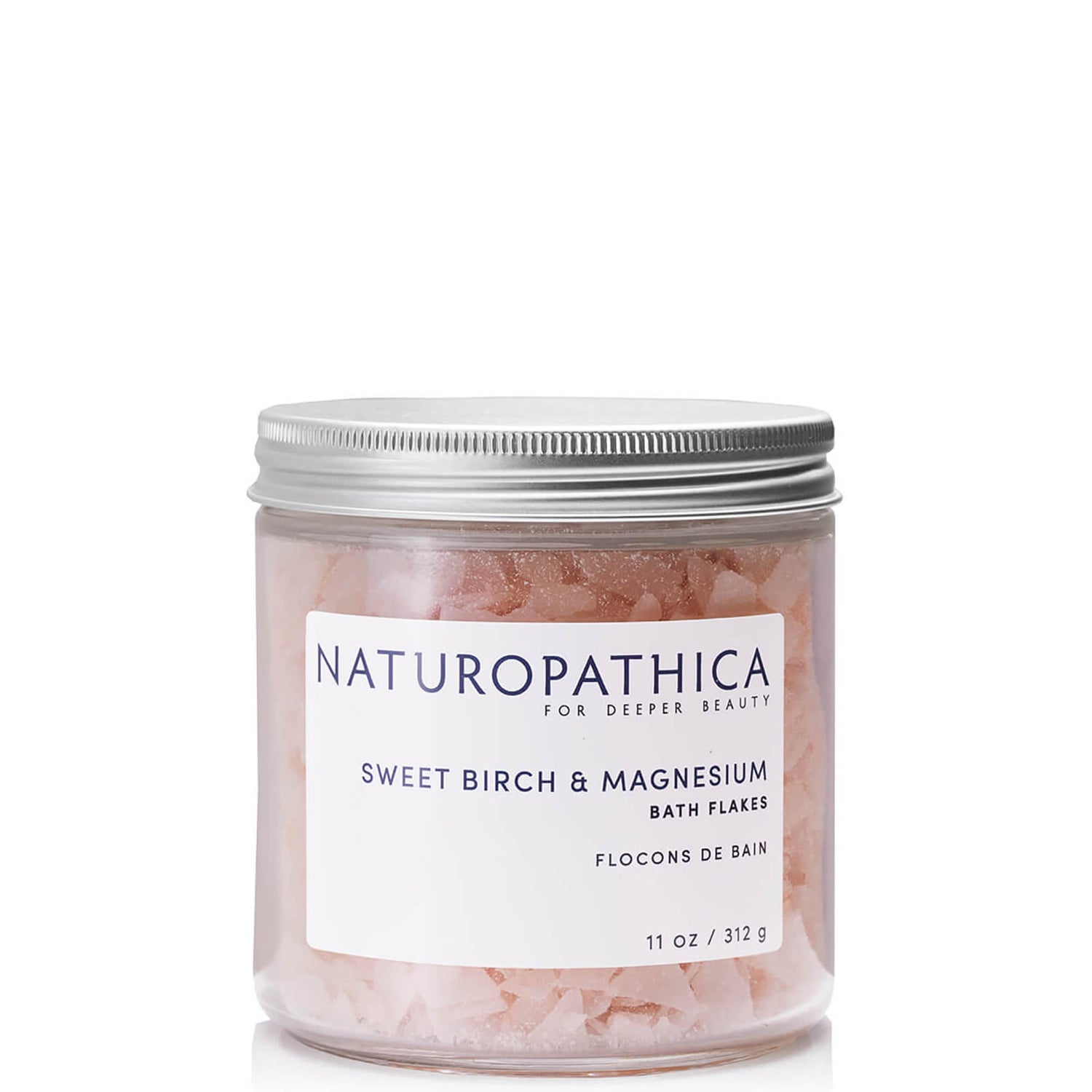 Nevertheless, the FDA lists it as an approved laxative (4, 12).
Nevertheless, the FDA lists it as an approved laxative (4, 12).
It can be taken by mouth with water according to the directions on the package.
You should also know that consuming Epsom salt may produce unpleasant side effects, such as bloating and liquid stool (13).
It should only be used occasionally as a laxative, not for long-term relief.
Exercise performance and recovery
Some people claim that taking Epsom salt baths can reduce muscle soreness and relieve cramps — both important factors for exercise performance and recovery.
It is well known that adequate magnesium levels are helpful for exercise because magnesium helps increase the availability of glucose in the blood, muscles, and brain while reducing the accumulation of lactic acid in the muscles (14).
While relaxing in a hot bath may help soothe aching muscles, there is no high quality evidence that people absorb bathwater magnesium through their skin (3).
On the other hand, oral supplements can effectively stave off magnesium insufficiency or deficiency.
Athletes are prone to low magnesium levels, so health professionals often recommend that they take magnesium supplements to ensure optimal levels (15).
While magnesium is clearly important for exercise, the use of bath salt to enhance fitness is not well researched. At this point, the supposed benefits are purely anecdotal.
Reduced pain and swelling
Another common claim is that Epsom salt helps reduce pain and swelling.
Many people report that taking Epsom salt baths improves symptoms of fibromyalgia and arthritis.
Again, the magnesium is deemed responsible for these effects, since many people with fibromyalgia and arthritis are deficient in this mineral (16, 17).
One 2015 study in 15 women with fibromyalgia concluded that applying magnesium chloride to the skin may be beneficial for reducing symptoms (18).
However, this study was based on questionnaires and lacked a control group. Its results should be taken with a grain of salt.
Summary
Most of the purported benefits of Epsom bath salts are anecdotal.
On the other hand, oral magnesium supplements may benefit sleep, stress, digestion, exercise, and pain in people who are deficient.
While Epsom salt is generally safe, there are a few negative effects that can occur when you take it by mouth.
First of all, the magnesium sulfate in it can have a laxative effect. Consuming it may result in diarrhea, bloating, or upset stomach (4, 13).
If you use it as a laxative, make sure to drink plenty of water, which may reduce digestive discomfort. Furthermore, never take more than the recommended dosage without first consulting a doctor.
In extreme cases, magnesium overdose can lead to heart problems, altered mental status, and death. This is unlikely as long as you take it in appropriate amounts as recommended by a doctor or listed on the package (19, 20).
Contact a doctor if you experience signs of an allergic reaction or other serious side effects.
Summary
The magnesium sulfate in Epsom salt can produce side effects when taken by mouth.
You can prevent these by using it correctly and talking with a doctor before increasing your dosage.
Here are a few of the most common ways to use Epsom salt.
Bath
The most common use is taking what’s called an Epsom salt bath.
To do this, add 2 cups, or about 475 grams (g), of Epsom salt to the water in a standard-sized bathtub and soak your body for at least 15 minutes.
You can also put the Epsom salt under running water if you want it to dissolve more quickly.
While hot baths can be relaxing, there is currently no good evidence for the benefits of an Epsom salt bath in itself.
Beauty
Epsom salt may be used as a beauty product for skin and hair. To use it as an exfoliant, just place some in your hand, dampen it and massage it into your skin.
Some people claim it’s a useful addition to facial wash, since it may help cleanse pores.
Just a 1/2 teaspoon (tsp), or 2.5 g, will do the trick. Simply combine it with your own cleansing cream and massage onto the skin.
It can also be added to conditioner and may help add volume to your hair. For this effect, combine equal parts conditioner and Epsom salt. Work the mixture through your hair and leave for 20 minutes, then rinse.
These uses are entirely anecdotal and unsupported by any studies. Remember that it works differently for everyone and that you may not experience the reported benefits.
Laxative
Epsom salt can be taken by mouth as a magnesium supplement or as a laxative.
Though there are no official guidelines for how much you should take, many brands recommend taking 2–6 tsp (10–30 g) per day, dissolved in water, as a maximum for adults, or around 1–2 tsp (5–10 g) for children.
Consult with a doctor if you need a more individualized dosage or if you want to increase the dose to more than what is listed on the package.
Unless you have the consent of a doctor, never ingest more than the upper limit of intake stated on the package. Taking more than you need could lead to magnesium sulfate poisoning.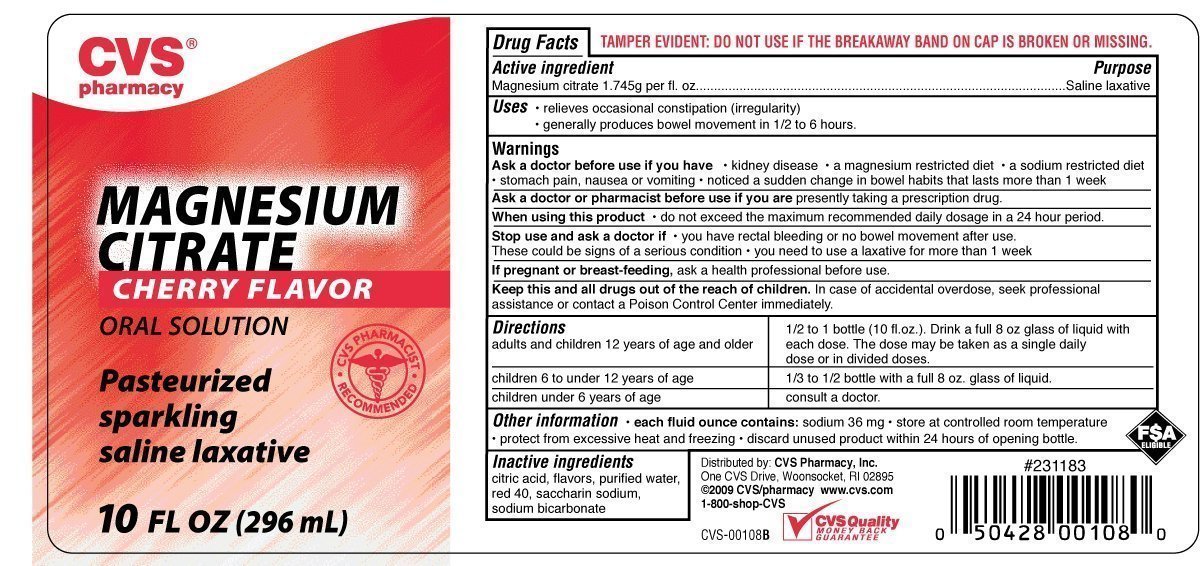
If you want to begin taking Epsom salt by mouth, start slowly and gradually increase the dose as needed.
Remember that everyone’s magnesium needs are different. You may need more or less than the recommended dose, depending on how your body reacts and what exactly you are using it for.
Additionally, when consuming Epsom salt, make sure to use pure, supplement-grade Epsom salt that does not have any added scents or coloring.
Summary
Epsom salt can be dissolved in baths and used as a beauty product. It can also be consumed with water as a magnesium supplement or laxative.
Epsom salt may be helpful for easing constipation when taken as a supplement. It can also be used as a beauty product or bath salt.
There isn’t a lot of evidence to support all of its reported benefits. Its positive effects are mostly anecdotal at this point, and more research is needed on its functions.
However, Epsom salt is generally safe and easy to use.
Benefits, Uses, and Side Effects
Epsom salt can be used as a supplement, bath salt, or beauty product. It’s also associated with very few side effects and may offer several potential health benefits.
Epsom salt is a popular remedy for many ailments.
People use it to ease health problems, such as muscle soreness and stress. It’s also affordable, easy to use, and harmless when used appropriately.
This article provides a comprehensive overview of Epsom salt, including its benefits, uses, and side effects.
Epsom salt is also known as magnesium sulfate. It’s a chemical compound made up of magnesium, sulfur, and oxygen.
Despite its name, Epsom salt is a completely different compound than table salt. It was most likely termed “salt” because of its chemical structure.
It has an appearance similar to table salt and is often dissolved in baths, which is why you may also know it as “bath salt.” While it looks similar to table salt, its taste is distinctly different. Epsom salt is quite bitter and unpalatable.
Epsom salt is quite bitter and unpalatable.
Some people still consume it by dissolving the salt in water and drinking it. However, due to its taste, you probably don’t want to add it to food.
For hundreds of years, this salt has been used to treat ailments, such as electrolyte abnormalities, constipation, and eclampsia. Unfortunately, its effects on many other conditions are not well researched (1).
Most of the reported benefits of Epsom salt are attributed to its magnesium, a mineral that a lot of people do not get enough of (2).
You can find Epsom salt online and at most drug and grocery stores. It’s typically located in the pharmacy or cosmetic area.
Summary
Epsom salt — otherwise known as bath salt or magnesium sulfate — is a mineral compound believed to have many health benefits.
When Epsom salt is dissolved in water, it releases magnesium and sulfate ions.
The idea is that these particles can be absorbed through your skin, providing you with magnesium and sulfates — which serve important bodily functions.
Despite claims on the contrary, there is no good evidence that magnesium or sulfates are absorbed into your body through the skin (3).
Yet the most common use for Epsom salt is in baths, where it is simply dissolved in bathwater.
It can also be applied to your skin as a cosmetic or taken by mouth as a laxative or magnesium supplement. However, because of its laxative effects, it might not be an ideal choice as a magnesium supplement if your goal is to prevent deficiency (4).
Summary
Epsom salt dissolves in water and can be added to baths or used as a cosmetic. However, there is no evidence that your body can absorb its minerals through the skin.
Many people, including some healthcare professionals, claim Epsom salt is therapeutic and use it as an alternative treatment for several conditions.
Provides magnesium
Magnesium is the fourth most abundant mineral in the body, the first being calcium (5).
It is involved in more than 300 biochemical reactions that benefit your heart and nervous system (5).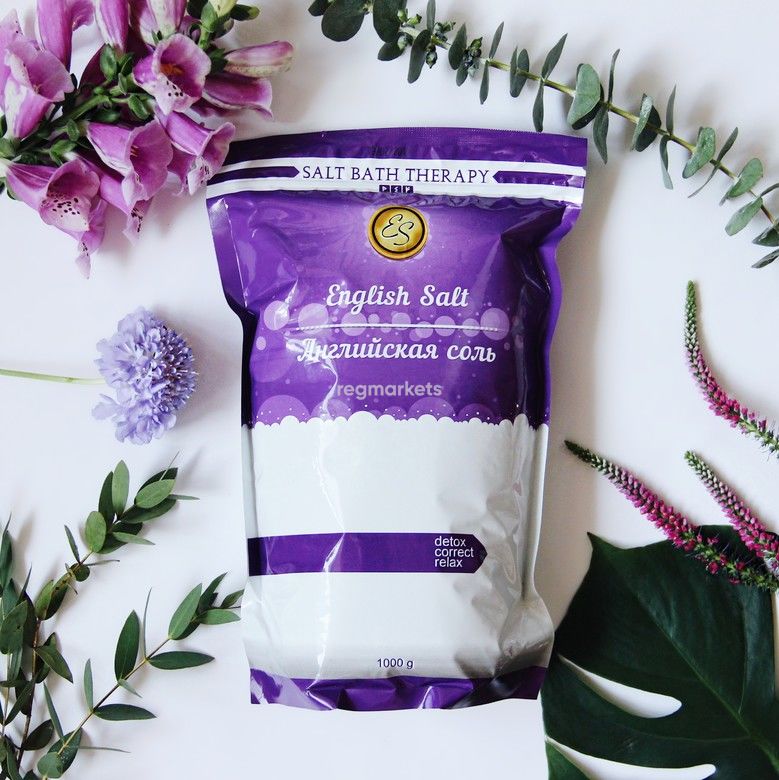
Still, many people do not consume enough magnesium (2).
While magnesium sulfate can be used as a magnesium supplement, some people claim that magnesium may be better absorbed via Epsom salt baths than when taken by mouth.
However, this claim is not based on any available evidence and research shows that magnesium sulfate is very poorly absorbed, even when taken orally (6).
Proponents of this theory point to an unpublished study in 19 healthy people. The researchers claimed that all but three of the participants showed higher blood magnesium levels after soaking in an Epsom salt bath.
However, no statistical tests were performed and the study lacked a control group (7).
Some other studies have also evaluated the effects of Epsom salt baths on blood magnesium levels, but these studies have turned up conflicting results and are of questionable quality (3).
Therefore, while it may be possible for magnesium to be absorbed through the skin, more large, high quality studies are needed (3).
Promotes sleep and stress reduction
Adequate magnesium levels are essential for sleep and stress management, likely because magnesium helps your brain produce neurotransmitters that induce sleep and reduce stress (8, 9).
Low magnesium levels may negatively affect sleep quality and stress. Some people claim that taking Epsom salt baths can reverse these issues by allowing your body to absorb magnesium through the skin. However, this hasn’t been scientifically proven.
It’s also possible that the calming effects of Epsom salt baths are simply due to the relaxation caused by taking hot baths.
Helps with constipation
Magnesium is often used to treat constipation.
It appears to be helpful because it draws water into your colon, which promotes bowel movements (10).
Most often, magnesium is taken by mouth for constipation relief in the form of magnesium citrate, magnesium hydroxide, or magnesium oxide (11).
Taking Epsom salt may also be effective, although it is not as well-studied as other forms. Nevertheless, the FDA lists it as an approved laxative (4, 12).
Nevertheless, the FDA lists it as an approved laxative (4, 12).
It can be taken by mouth with water according to the directions on the package.
You should also know that consuming Epsom salt may produce unpleasant side effects, such as bloating and liquid stool (13).
It should only be used occasionally as a laxative, not for long-term relief.
Exercise performance and recovery
Some people claim that taking Epsom salt baths can reduce muscle soreness and relieve cramps — both important factors for exercise performance and recovery.
It is well known that adequate magnesium levels are helpful for exercise because magnesium helps increase the availability of glucose in the blood, muscles, and brain while reducing the accumulation of lactic acid in the muscles (14).
While relaxing in a hot bath may help soothe aching muscles, there is no high quality evidence that people absorb bathwater magnesium through their skin (3).
On the other hand, oral supplements can effectively stave off magnesium insufficiency or deficiency.
Athletes are prone to low magnesium levels, so health professionals often recommend that they take magnesium supplements to ensure optimal levels (15).
While magnesium is clearly important for exercise, the use of bath salt to enhance fitness is not well researched. At this point, the supposed benefits are purely anecdotal.
Reduced pain and swelling
Another common claim is that Epsom salt helps reduce pain and swelling.
Many people report that taking Epsom salt baths improves symptoms of fibromyalgia and arthritis.
Again, the magnesium is deemed responsible for these effects, since many people with fibromyalgia and arthritis are deficient in this mineral (16, 17).
One 2015 study in 15 women with fibromyalgia concluded that applying magnesium chloride to the skin may be beneficial for reducing symptoms (18).
However, this study was based on questionnaires and lacked a control group. Its results should be taken with a grain of salt.
Summary
Most of the purported benefits of Epsom bath salts are anecdotal.
On the other hand, oral magnesium supplements may benefit sleep, stress, digestion, exercise, and pain in people who are deficient.
While Epsom salt is generally safe, there are a few negative effects that can occur when you take it by mouth.
First of all, the magnesium sulfate in it can have a laxative effect. Consuming it may result in diarrhea, bloating, or upset stomach (4, 13).
If you use it as a laxative, make sure to drink plenty of water, which may reduce digestive discomfort. Furthermore, never take more than the recommended dosage without first consulting a doctor.
In extreme cases, magnesium overdose can lead to heart problems, altered mental status, and death. This is unlikely as long as you take it in appropriate amounts as recommended by a doctor or listed on the package (19, 20).
Contact a doctor if you experience signs of an allergic reaction or other serious side effects.
Summary
The magnesium sulfate in Epsom salt can produce side effects when taken by mouth.
You can prevent these by using it correctly and talking with a doctor before increasing your dosage.
Here are a few of the most common ways to use Epsom salt.
Bath
The most common use is taking what’s called an Epsom salt bath.
To do this, add 2 cups, or about 475 grams (g), of Epsom salt to the water in a standard-sized bathtub and soak your body for at least 15 minutes.
You can also put the Epsom salt under running water if you want it to dissolve more quickly.
While hot baths can be relaxing, there is currently no good evidence for the benefits of an Epsom salt bath in itself.
Beauty
Epsom salt may be used as a beauty product for skin and hair. To use it as an exfoliant, just place some in your hand, dampen it and massage it into your skin.
Some people claim it’s a useful addition to facial wash, since it may help cleanse pores.
Just a 1/2 teaspoon (tsp), or 2.5 g, will do the trick. Simply combine it with your own cleansing cream and massage onto the skin.
It can also be added to conditioner and may help add volume to your hair. For this effect, combine equal parts conditioner and Epsom salt. Work the mixture through your hair and leave for 20 minutes, then rinse.
These uses are entirely anecdotal and unsupported by any studies. Remember that it works differently for everyone and that you may not experience the reported benefits.
Laxative
Epsom salt can be taken by mouth as a magnesium supplement or as a laxative.
Though there are no official guidelines for how much you should take, many brands recommend taking 2–6 tsp (10–30 g) per day, dissolved in water, as a maximum for adults, or around 1–2 tsp (5–10 g) for children.
Consult with a doctor if you need a more individualized dosage or if you want to increase the dose to more than what is listed on the package.
Unless you have the consent of a doctor, never ingest more than the upper limit of intake stated on the package. Taking more than you need could lead to magnesium sulfate poisoning.
If you want to begin taking Epsom salt by mouth, start slowly and gradually increase the dose as needed.
Remember that everyone’s magnesium needs are different. You may need more or less than the recommended dose, depending on how your body reacts and what exactly you are using it for.
Additionally, when consuming Epsom salt, make sure to use pure, supplement-grade Epsom salt that does not have any added scents or coloring.
Summary
Epsom salt can be dissolved in baths and used as a beauty product. It can also be consumed with water as a magnesium supplement or laxative.
Epsom salt may be helpful for easing constipation when taken as a supplement. It can also be used as a beauty product or bath salt.
There isn’t a lot of evidence to support all of its reported benefits. Its positive effects are mostly anecdotal at this point, and more research is needed on its functions.
However, Epsom salt is generally safe and easy to use.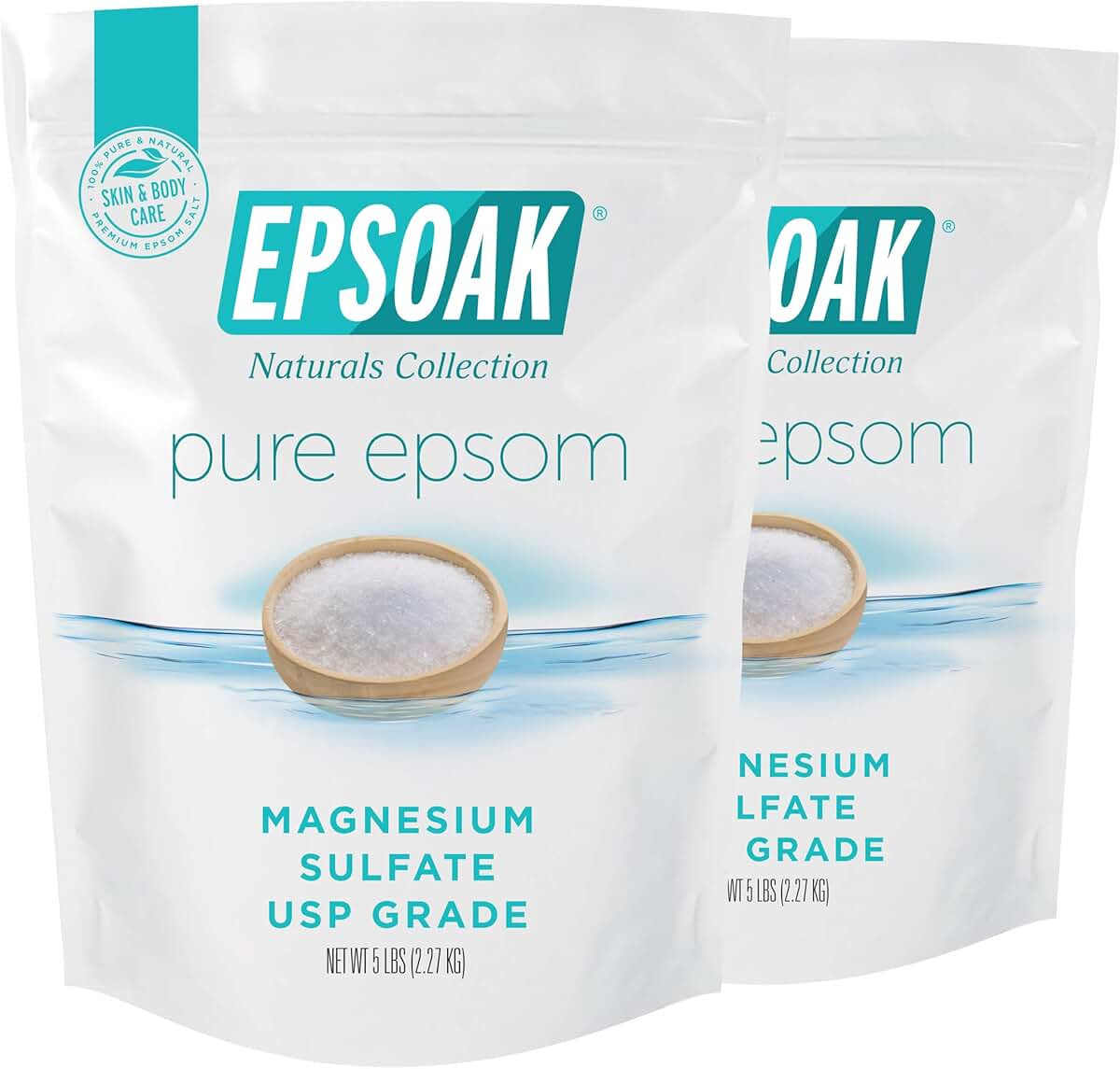
Magnesium bath: benefits, recommendations, contraindications
Perhaps during the pandemic you have come across articles about magnesium more than once or you were advised to take supplements with this mineral by a therapist or neurologist. Spring and stress is the time to remember that it is important to replenish its deficit regularly. A pleasant way to do this is magnesium salt baths.
But how do you recognize a magnesium deficiency? “If your skin dries, you crave sweets in the evenings, you don’t sleep well and you’re lashing out at your loved ones in the morning, you most likely have a magnesium deficiency,” says Svetlana Kovaleva, dermatologist, cosmetologist at Professor Kalinchenko’s Clinic. “Of course,” she adds, “you can take tests and check the balance of vitamins and trace elements – this is a good and useful thing, but even if we assume that he does not reveal magnesium deficiency, it can form at any moment.”
The amazing thing that happens to this mineral is that it can disappear quickly.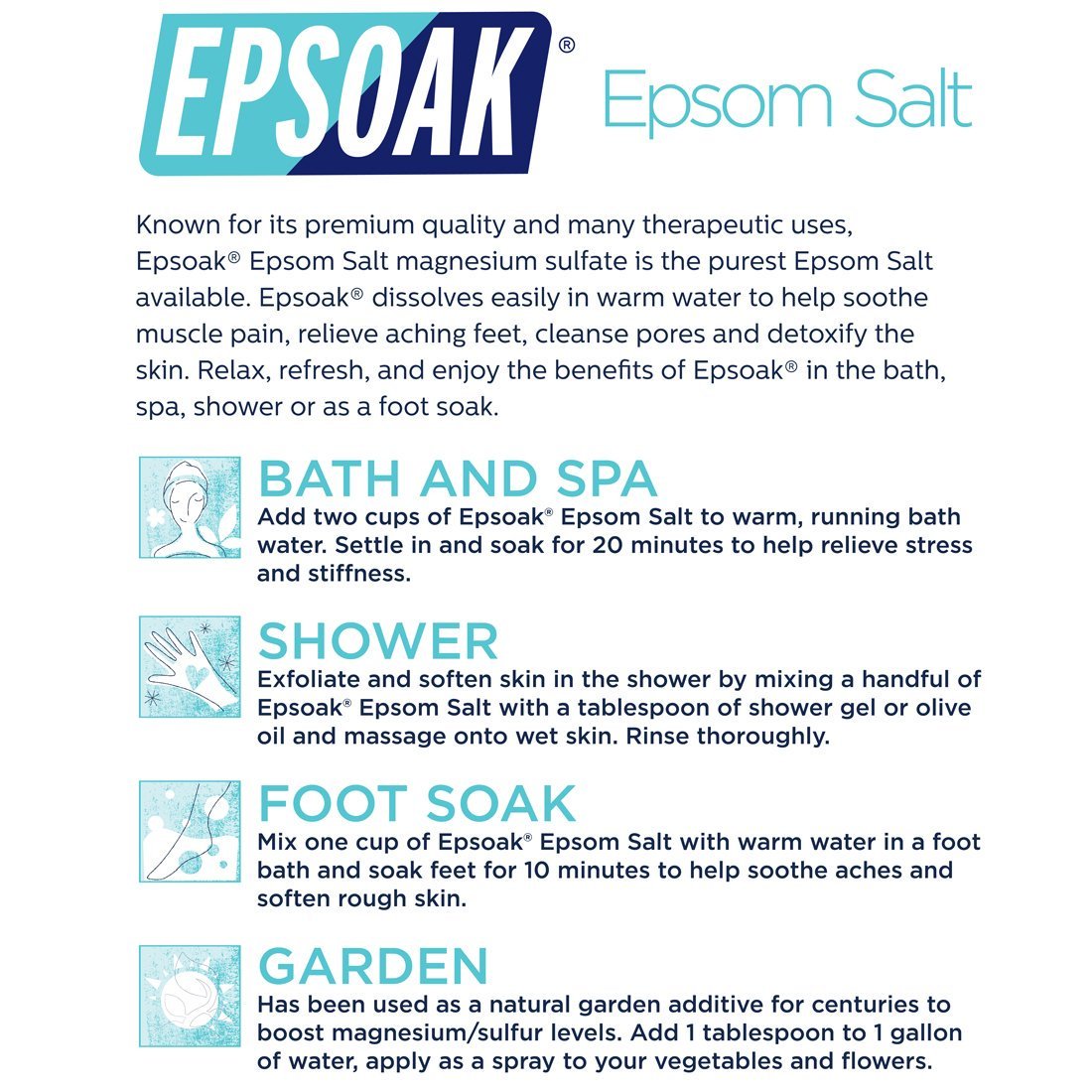
If you already have this element in short supply, a sharp quarrel with your husband is enough for all the magnesium to “work out”. So resolving conflicts peacefully is also a great way to maintain the balance of trace elements in the body. At the same time, an excess of magnesium – hypermagnesemia – is an extremely rare phenomenon and can occur with kidney failure.
Why do we need magnesium?
It is involved in more than 600 chemical reactions of cells that occur in our body. “Magnesium is essential at all stages of protein synthesis. It is involved in maintaining the normal function of the nervous system and heart muscles, has a vasodilating effect, stimulates bile secretion, increases intestinal activity, and lowers bad cholesterol,” says Svetlana Grebenkova, health coach, member of the Association of Educational and Functional Medicine Specialists. – Lack of magnesium in the body can cause insomnia, chronic fatigue, osteoporosis, arthritis, fibromyalgia, migraine, muscle cramps and spasms, cardiac arrhythmia, constipation, PMS. And this is not a complete list. The body’s need for magnesium increases many times if you use alcohol, laxatives, diuretics, with great mental and physical stress.
And this is not a complete list. The body’s need for magnesium increases many times if you use alcohol, laxatives, diuretics, with great mental and physical stress.
By the way, the much-loved vitamin D is very poorly absorbed in magnesium deficiency.
Recommended magnesium intake for women: 310 mg per day up to age 30, 320 mg for those over 30. Magnesium is found in dark green leafy vegetables, cocoa, eggs, legumes, fruits and dried fruits, nuts, and whole grains. It is not synthesized by itself in the body. Therefore, doctors so often recommend drinking water with magnesium and taking magnesium supplements, preferably in powder form, but this is a separate issue.
And now about pleasant things. What are magnesium baths?
Another way to compensate for magnesium deficiency was suggested by balneotherapists – specialists in the treatment of diseases with the help of mineral waters and water procedures. If you have ever been to a sanatorium, probably the first thing you were offered was a course of baths.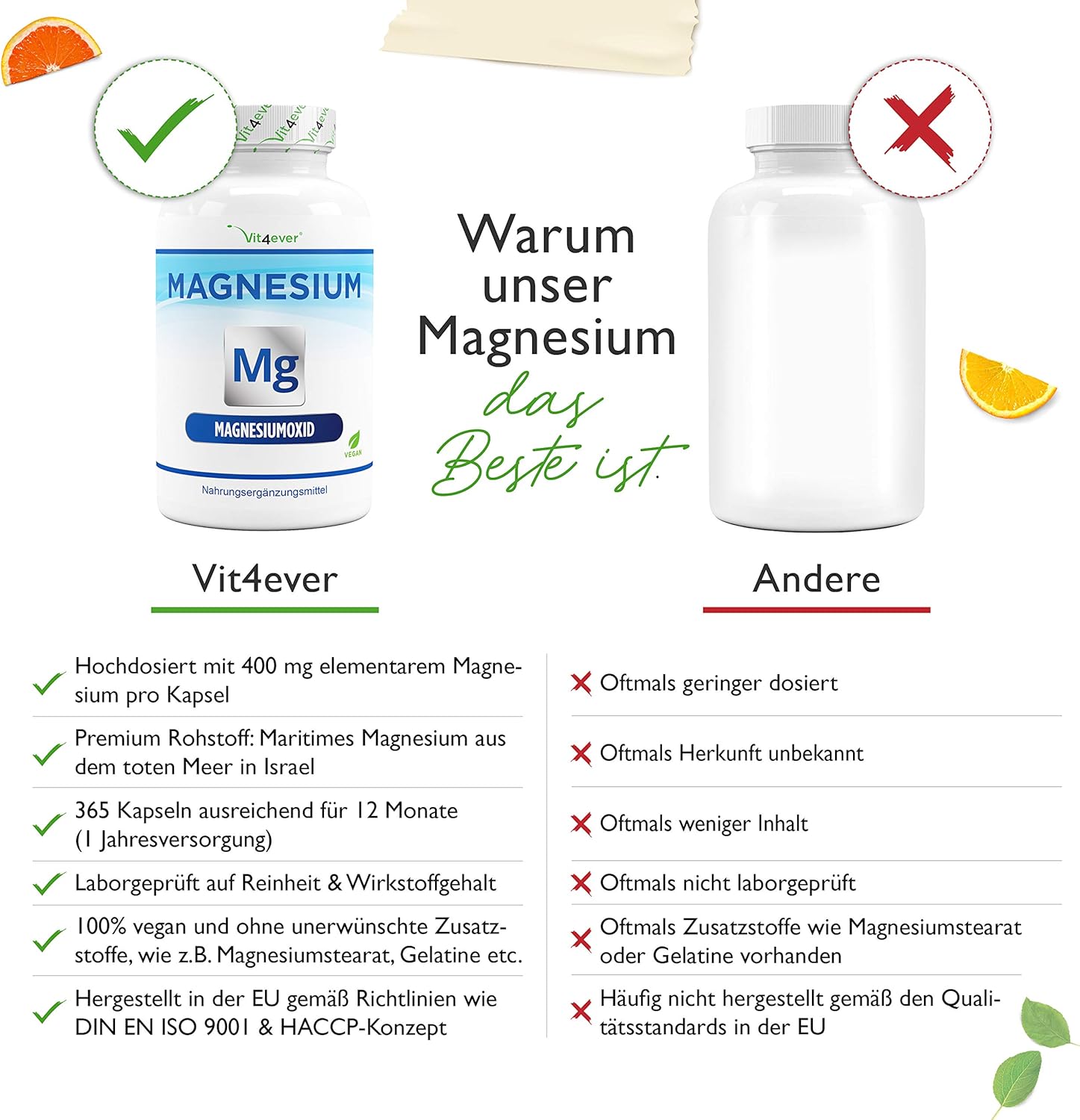 They can be called magnesia, magnesium, sea or bischofite, and this is the most popular procedure in spa treatment. Her list of contraindications is minimal – the main thing is to follow simple rules. And the list of diseases in which magnesium baths are useful is huge: from osteochondrosis and hypertension to gynecological and dermatological.
They can be called magnesia, magnesium, sea or bischofite, and this is the most popular procedure in spa treatment. Her list of contraindications is minimal – the main thing is to follow simple rules. And the list of diseases in which magnesium baths are useful is huge: from osteochondrosis and hypertension to gynecological and dermatological.
Magnesium bath is that rare spa treatment that is easy to repeat at home.
The main thing is that you have a bath. And it is better to do it before going to bed, because it perfectly relaxes and is recognized as one of the most effective ways to improve sleep. For those who suffer from insomnia, it can help to do without pills.
“There are two types of magnesium bath salts: Epsom salt (magnesium sulfate) and bischofite (magnesium chloride). A bath with this salt helps replenish magnesium in the body, activates the process of restoration and regeneration of skin cells, promotes weight loss by removing toxins and excess fluid from the body, strengthens the protective barrier of the skin and increases overall resistance to pathogenic microorganisms, improves blood circulation and prevents the development of varicose veins, normalizes the functioning of the sebaceous glands, which prevents the formation of acne, disinfects the scalp and has an antifungal effect, strengthens the hair follicles and improves the blood circulation of the scalp,” lists the properties of magnesium baths Anton Rumyantsev, CEO of Salt of the Earth, the main supplier of Epsom Epsom salt.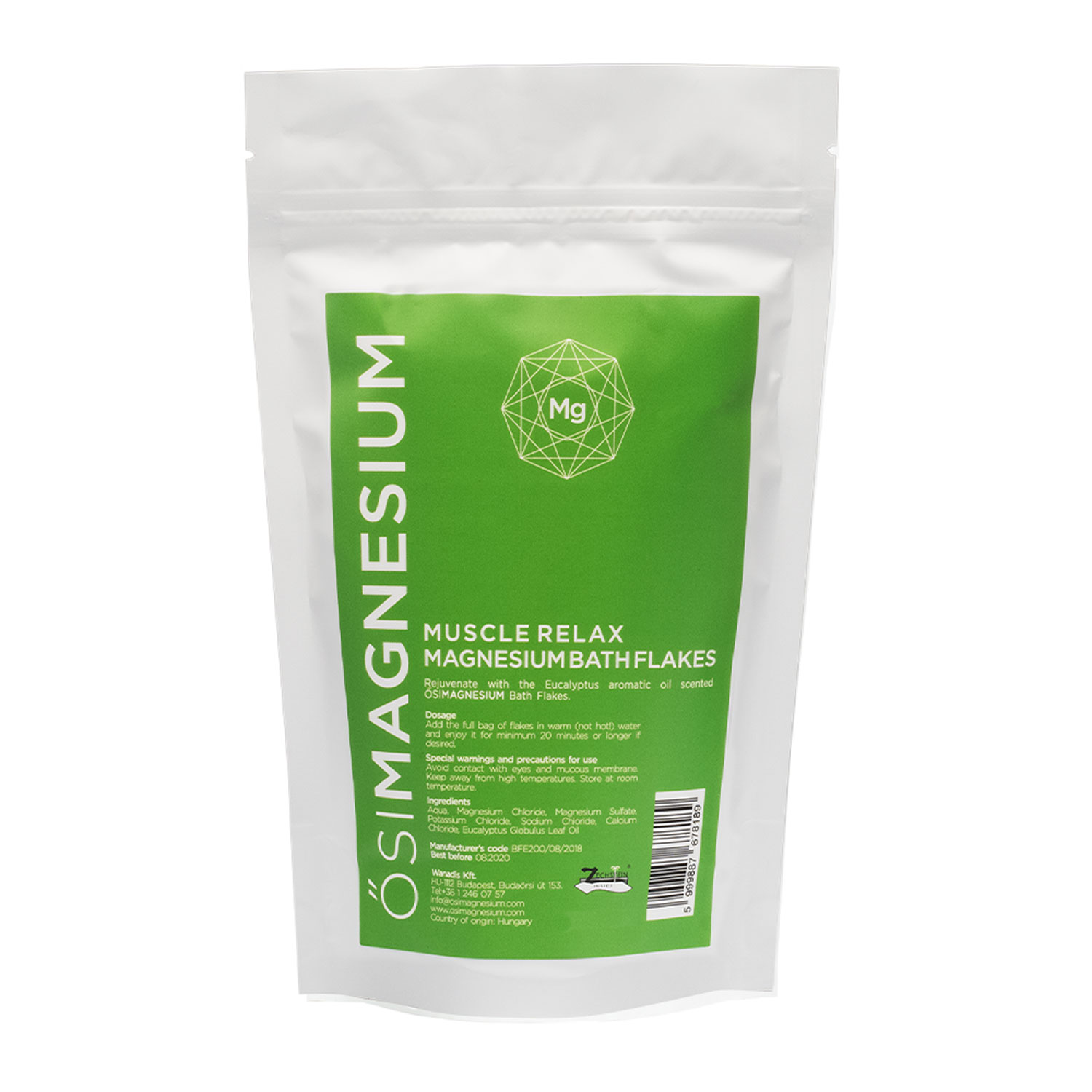 Pro.
Pro.
For history buffs, a bit of storytelling about Epsom salt and bischofite. In 1696, salt (almost 100% magnesium sulfate) was isolated from the mineral water of the Epsom Spring in England, which had a bitter taste and laxative effect. Apothecaries called it bitter salt, as well as Epsom salt or Epsom salt. Since then, baths with Epsom salt have been used in spa therapy, they are prescribed when a person, for some reason, cannot take magnesium supplements, but is in deficiency, during periods of stress and increased overexcitation, muscle pain and increased physical exertion.
Bischofite is a complex of minerals of natural origin, it is believed that it arose as a result of the evaporation of ancient seas. Named after the German geologist Carl-Gustow Bischof, who discovered it in Germany in 1877. In the middle of the last century, bischofite deposits were discovered in Russia, there are many of them in the Volgograd region. Therefore, in our sanatoriums, baths with bischofite are more common.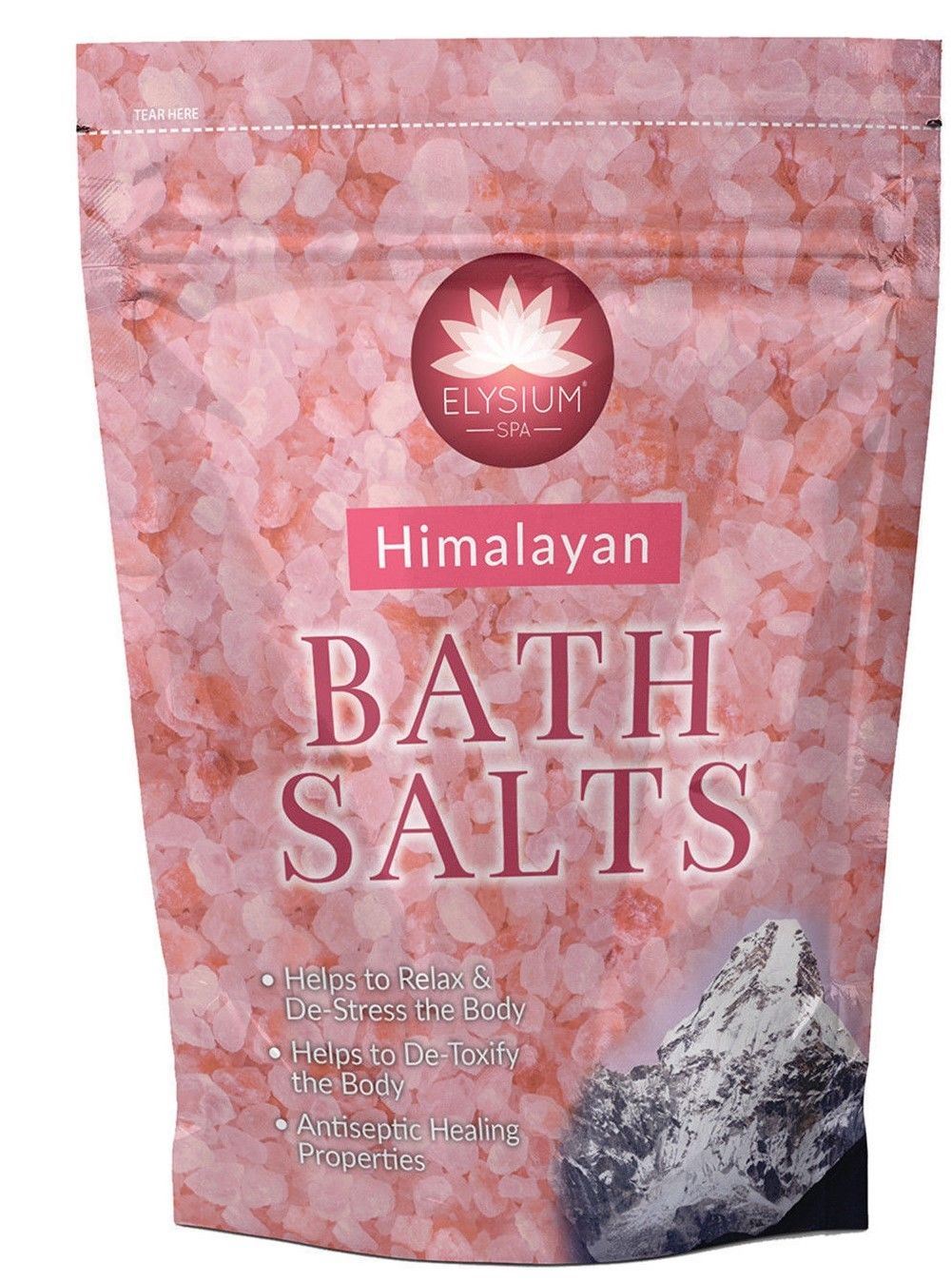 In terms of cost, it is much more affordable.
In terms of cost, it is much more affordable.
The most important thing!
And now remember the rules for taking a magnesium bath at home. They are very simple. You will need 400-500 g of Epsom salts or 500 g (for a child) to 1 kg (for an adult) of bischofite. Dissolve the salt in warm but not hot water (up to 40 degrees). Take a bath for 20 minutes. A possible maximum is half an hour, but, as a rule, even 15 is enough for most people, since the bath is very relaxing and after it you want to be in bed as soon as possible. You don’t need to take a shower after, just pat your body dry with a towel.
“If you want to improve your sleep, take magnesium baths for ten treatments every other day. For additional relaxation, you can add a few drops of essential oil – coniferous, lavender, and in a period of severe stress – lemongrass or vanilla. Just remember: essential oils are never (!) added directly to water. Oil and water do not mix with each other, they need an emulsifier.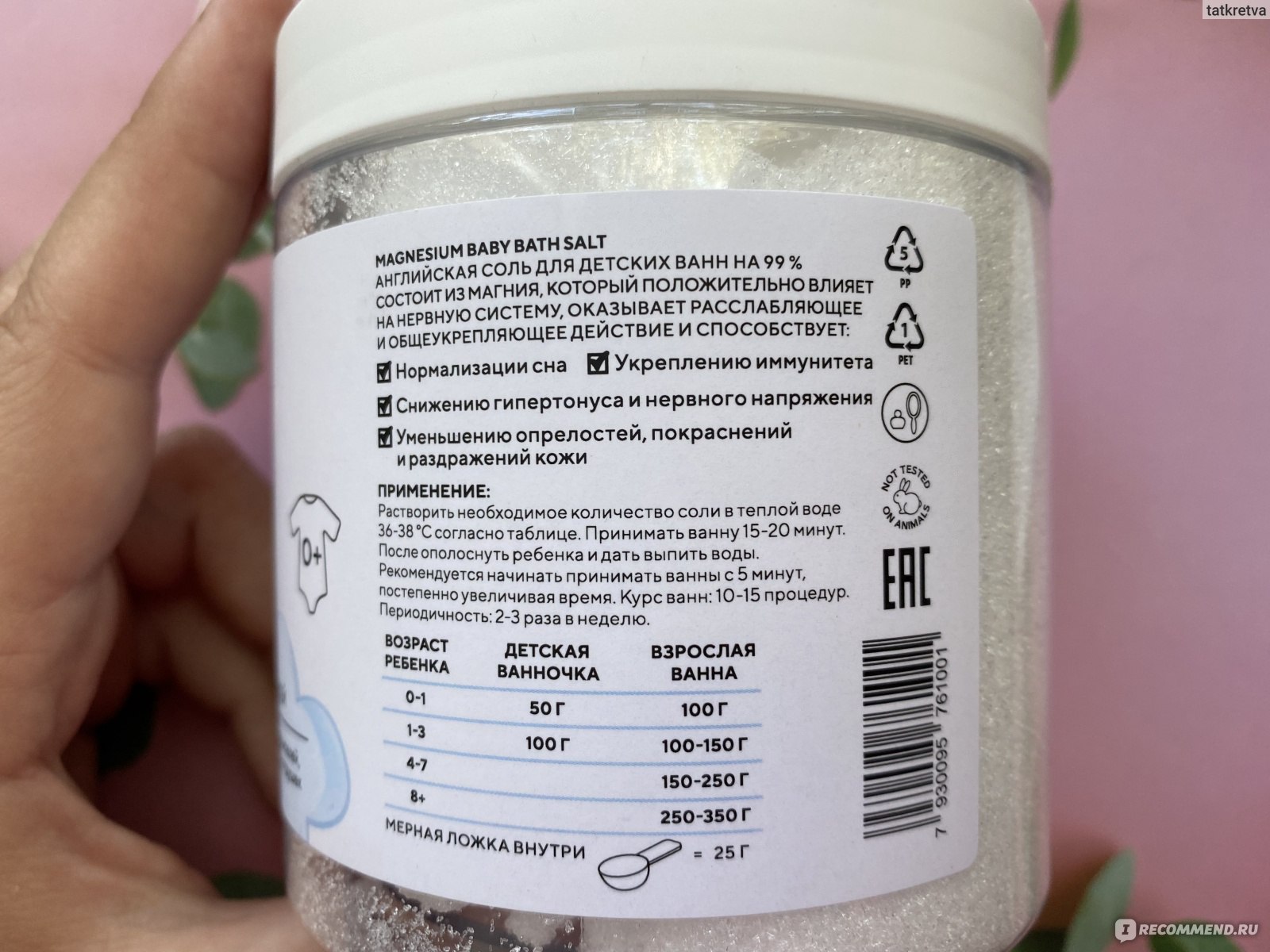 And salt, sea or magnesium, is the same emulsifier. Therefore, add oil to salt, stir, and then dissolve the salt in water, Svetlana Grebenkova recommends. – And don’t overdo it. The scheme is like this. On the first day, add five drops of essential oil per bath (in 500 g of salt), on the second day – seven drops, on the third day – ten drops, on the fourth day – 15 drops, on the fifth day – 17 drops, on the sixth day – 20 drops, on the seventh day – 15 drops, on the eighth day – ten drops, on the ninth day – seven drops, on the tenth day – again five drops of essential oil, with which we started.
And salt, sea or magnesium, is the same emulsifier. Therefore, add oil to salt, stir, and then dissolve the salt in water, Svetlana Grebenkova recommends. – And don’t overdo it. The scheme is like this. On the first day, add five drops of essential oil per bath (in 500 g of salt), on the second day – seven drops, on the third day – ten drops, on the fourth day – 15 drops, on the fifth day – 17 drops, on the sixth day – 20 drops, on the seventh day – 15 drops, on the eighth day – ten drops, on the ninth day – seven drops, on the tenth day – again five drops of essential oil, with which we started.
Be sure to take a break after a course of baths.”
And if you need another proof to try magnesium baths, here it is. Last year, Trendanalytics included magnesium in the top 20 most promising beauty ingredients. For regenerating and restoring properties (remember that dermatologists recommend baths with magnesium ions even for psoriasis and eczema). So, in addition to bath salts, magnesium can also be found in skin and hair care products. We’re sure there will be more of these soon.
We’re sure there will be more of these soon.
Epsom salt: uses, benefits and contraindications
05/24/2023 02:34
Epsom, magnesium, bitter – all this is one salt, which was obtained several centuries ago near a small English town. Since then, it has firmly established itself in the ranking of useful tools. Doctors prescribe it for increased fatigue, chronic stress, insomnia, body pain, skin problems.
What is so great about this product and how to use it correctly to achieve maximum effect? We learned about it from Dmitry Kadantsev, General Director of KAST-EXPO , a company whose main specialization is the production of products based on magnesium salt.
What is magnesium salt and how does it differ from ordinary sea salt? Epsom. It tastes bitter, and despite the fact that it looks like ordinary salt, it is not used in cooking. But it is actively used in cosmetology and medicine.
It differs from the usual bath salts in its composition: ordinary salt is sodium chloride, English salt is magnesium sulfate.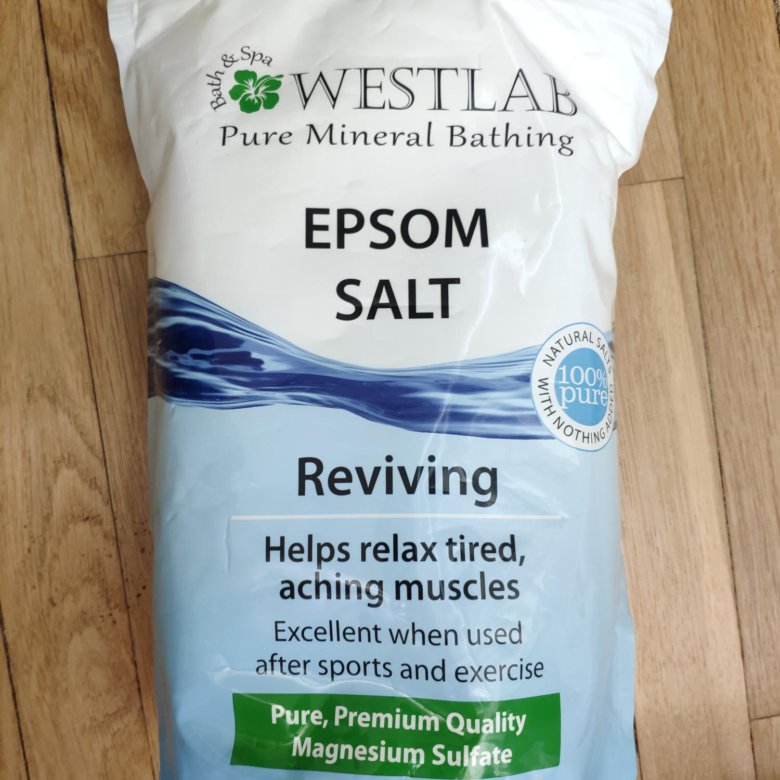 At the same time, the packaging indicates what percentage of the substance the product contains. So, the best indicator of quality at the moment is 99.9% magnesium sulfate content. The remaining 0.01% are impurities.
At the same time, the packaging indicates what percentage of the substance the product contains. So, the best indicator of quality at the moment is 99.9% magnesium sulfate content. The remaining 0.01% are impurities.
Another difference is the effect on the skin. While Epsom salt improves skin and hair condition, reduces inflammation, makes the surface supple and smooth, sea salt dries the skin and removes moisture, which in some cases leads to itching and irritation.
Epsom salts are considered the best bath salts today.
Epsom salt, 3 kg
from 586 ₽
Buy on the brand website Due to the lack of this substance, the nervous system suffers, muscle cramps, joint pain, metabolic disturbances, apathy, insomnia, and so on appear. Therefore, when correcting these conditions, in addition to dietary supplements, doctors prescribe Epsom salt baths. And in some cases, when the problems become chronic, such baths are taken on a regular basis.
Magnesium salt is also very useful for children.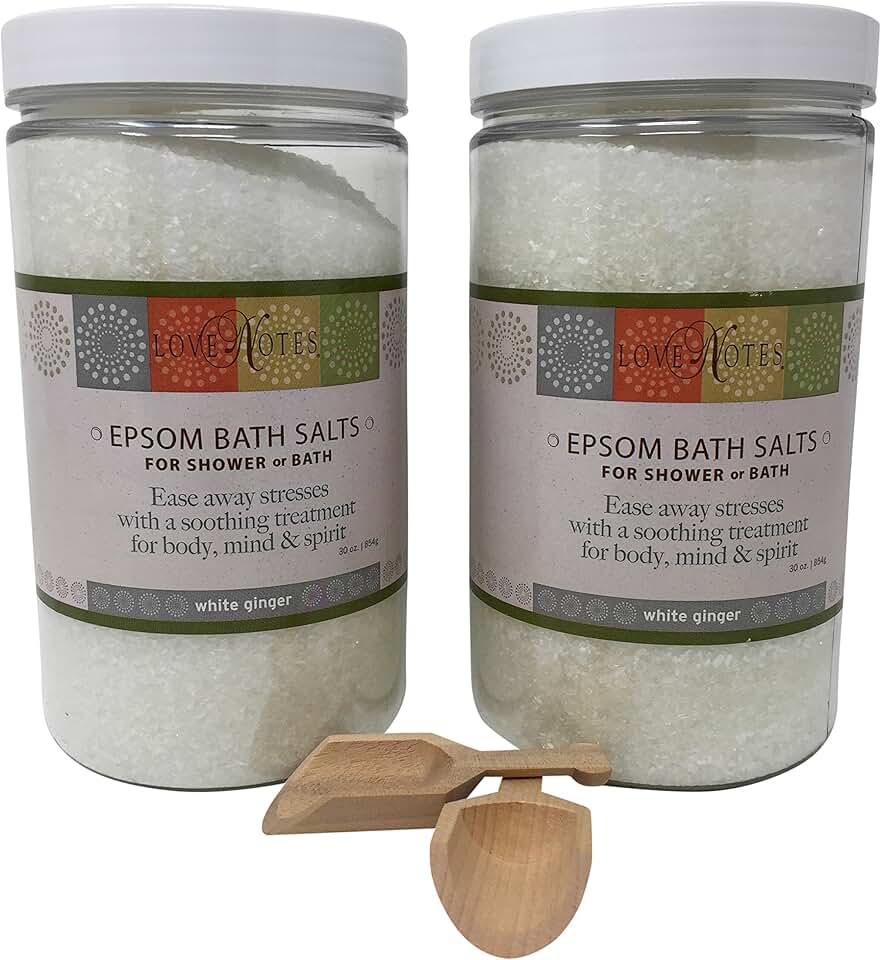 Baths with it relieve tension, relax, relieve the symptoms of hypertonicity, help with diaper rash and dermatitis, and stabilize emotions. Children after such baths sleep soundly and sweetly.
Baths with it relieve tension, relax, relieve the symptoms of hypertonicity, help with diaper rash and dermatitis, and stabilize emotions. Children after such baths sleep soundly and sweetly.
Epsom Epsom salt for children, 1.2 kg
from 464 ₽
hypertension, rehabilitation period after surgery, oncology, epilepsy. In general, all those conditions in which it is not recommended to stay in hot water for a long time.
Beauty recipes: how to properly take magnesium baths
For maximum relaxation we recommend:
- Fill with warm water. At the same time, it is important that the water temperature is not lower than 37 degrees, otherwise there is a chance to get an invigorating, rather than relaxing effect.
- Add 250-500 grams Epsom salts. If desired, you can drop a few drops of essential oil to enhance the healing effect and get your favorite aroma.
- Take a bath for no more than 30 minutes (ideally – 15-20).
- During the procedure, do not forget to drink clean water.
 Take care of this in advance – take a glass of drinking water or herbal tea with you.
Take care of this in advance – take a glass of drinking water or herbal tea with you.
Scented candles, relaxing music and a favorite book will help to complete the spa effect.
How else can you use magnesium salt at home
In addition to general baths, you can do baths for hands and feet – for example, before manicure and pedicure. It has been proven that the shortest transdermal route of exposure is through the feet (that is, the skin absorbs better in this area of the body). Magnesium also strengthens the nail plates.
But the most interesting thing is the opportunity to make a variety of scrubs for the scalp and body. It is enough to mix salt with shampoo or honey, then apply to the skin and gently massage. Thanks to such simple manipulations, blood circulation improves, lymph accelerates, and a light massage effect is obtained. Detailed recipes can be found on the website KAST-EXPO .
For those who do not want to bother, there are ready-made scrubs based on Epsom salts. It is also a very entertaining product that stimulates metabolic processes.
It is also a very entertaining product that stimulates metabolic processes.
Mint body scrub
from 429 ₽
Buy on the brand website
How KAST-EXPO products differ from similar products on the market
The quality of magnesium salt can be monitored by several indicators.
First of all, this is GOST. Cosmetic and industrial salts are different, and the latter should never be used for baths or scrubs. Outwardly, they also differ from each other: the cosmetic product is more whitish, and the technical product is more like sugar.
Secondly, pay attention to the percentage of magnesium sulfate. Well, if it is 99%, very good – if 99.9%. The higher this indicator, the less impurities the product contains. And impurities, unfortunately, are more often harmful to the body.
Products KAST-EXPO fully complies with all of the above. We are the largest representative of magnesium sulfate manufacturers in the CIS. In our assortment there are not only adult, but also children’s products with all the relevant safety certificates.

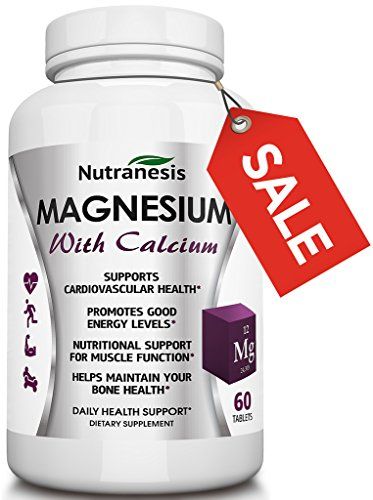 On the other hand, oral magnesium supplements may benefit sleep, stress, digestion, exercise, and pain in people who are deficient.
On the other hand, oral magnesium supplements may benefit sleep, stress, digestion, exercise, and pain in people who are deficient.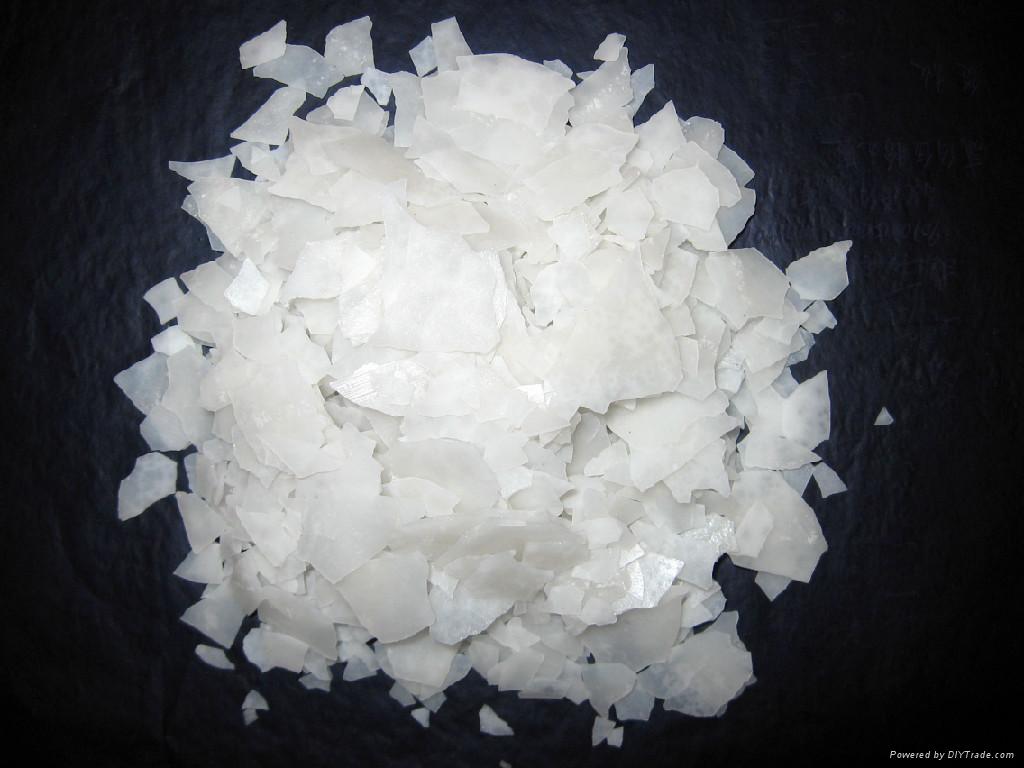 You can prevent these by using it correctly and talking with a doctor before increasing your dosage.
You can prevent these by using it correctly and talking with a doctor before increasing your dosage.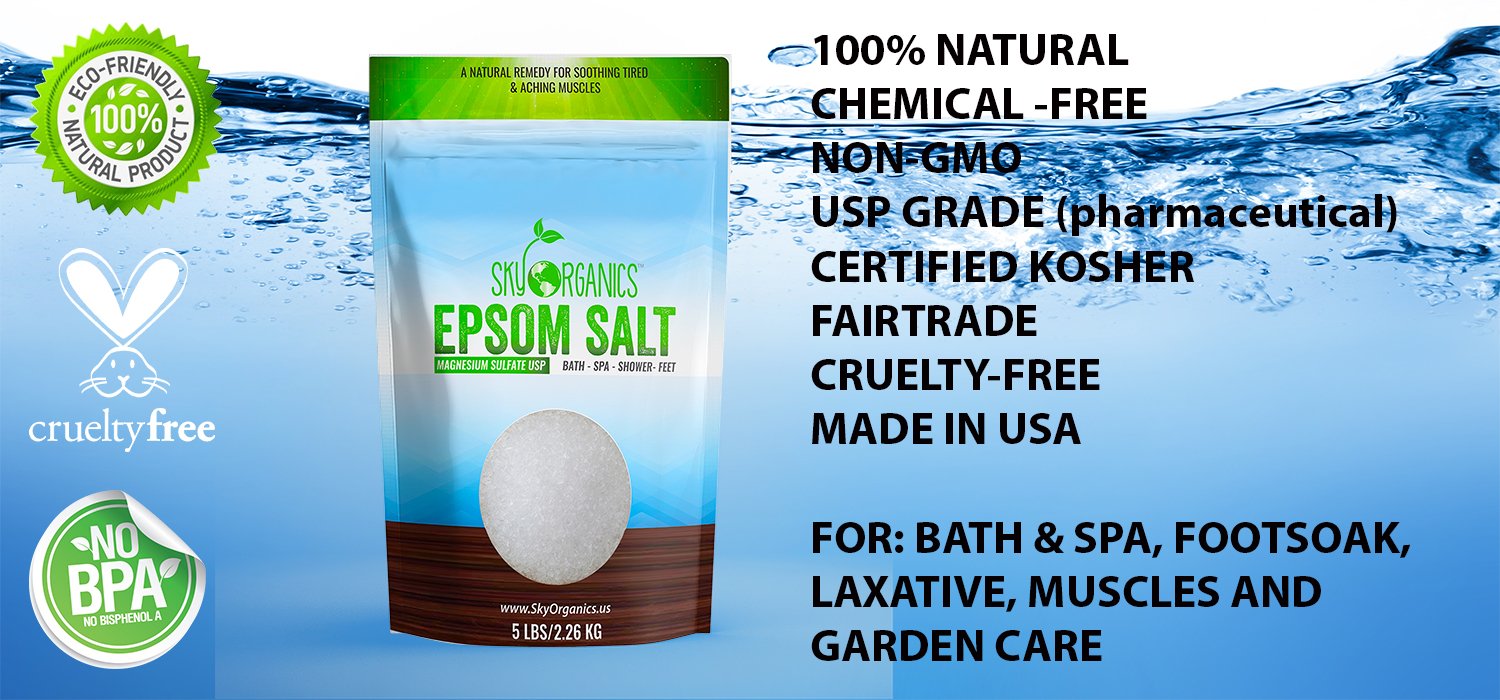 On the other hand, oral magnesium supplements may benefit sleep, stress, digestion, exercise, and pain in people who are deficient.
On the other hand, oral magnesium supplements may benefit sleep, stress, digestion, exercise, and pain in people who are deficient. You can prevent these by using it correctly and talking with a doctor before increasing your dosage.
You can prevent these by using it correctly and talking with a doctor before increasing your dosage.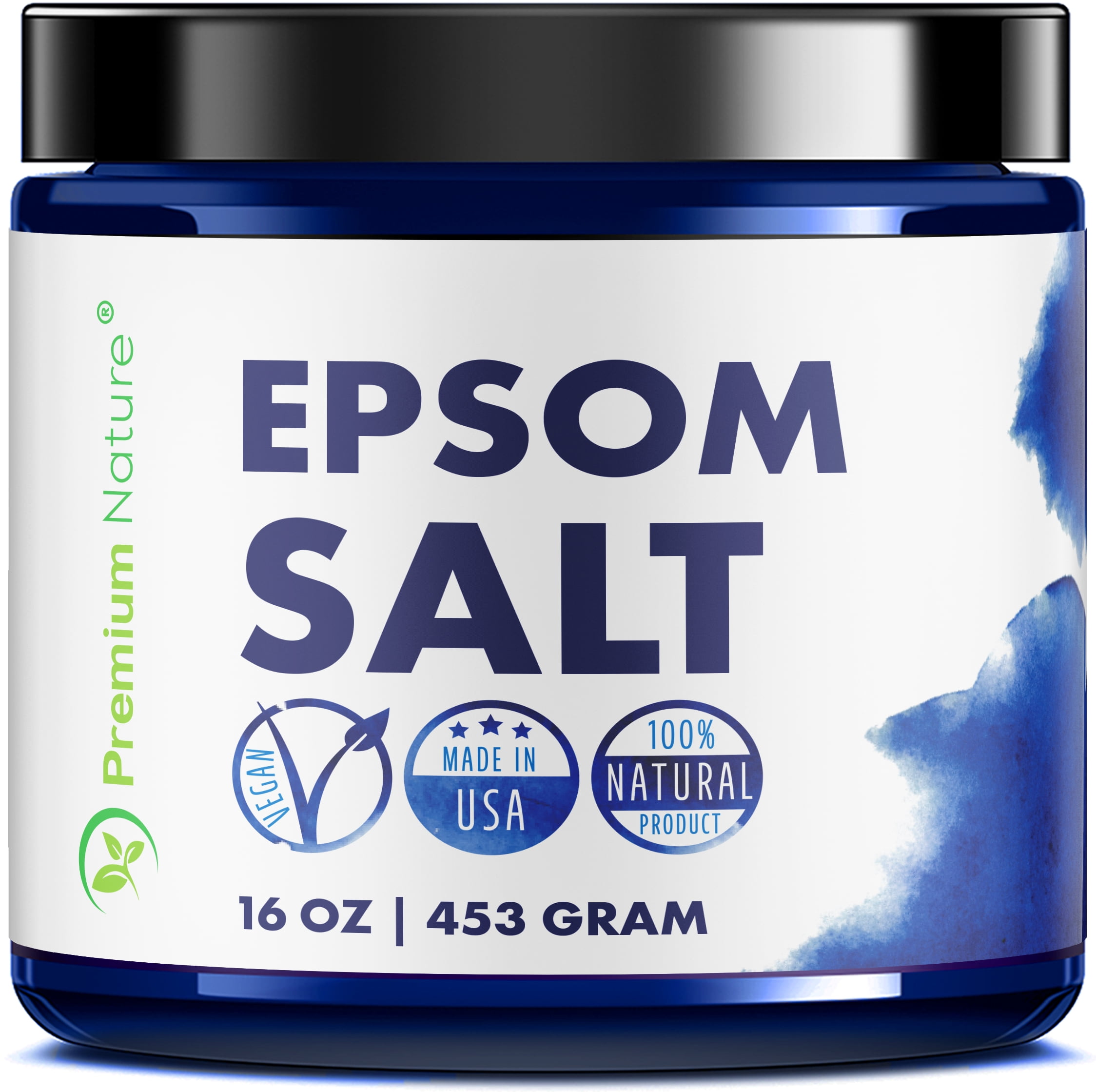 Take care of this in advance – take a glass of drinking water or herbal tea with you.
Take care of this in advance – take a glass of drinking water or herbal tea with you.